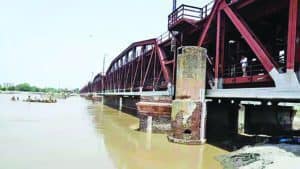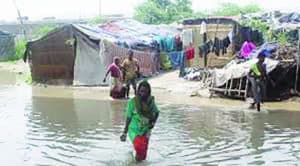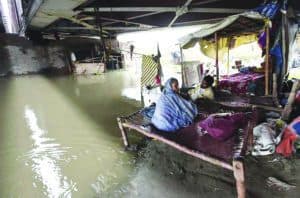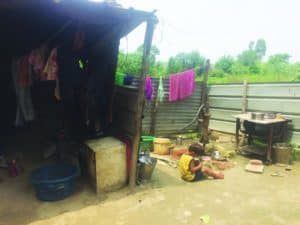When Yamuna’s water level rises, fear grips the Yamuna dwellers who continue to lead a precarious life, entangled in the process of settlement and resettlement as the Yamuna swells and recedes. A look into their lives after the recent flood threat…
Inundated mud stoves, a rotten lot of vegetables and grains, soiled sheets and a ramshackle hutment welcomed Rani, 25, when she came back from the relief camp. “On returning, we saw muck all around and many items were covered in slime. Our crops were ruined,” she says, highlighting the miserable days that lie ahead.
Rani lives in one of the many jhuggis on the Yamuna bank near the Shastri Park area. A rugged slope leads down to a cluster of jhuggis that house hundreds of people. She is one of the 20,000 people who were resettled in relief camps after the water level at the Loha Pul (Old Yamuna Bridge) — used to assess how much the Yamuna has swelle — reached past the danger mark of 204.83m to 205.30m, prompting authorities to evacuate people from several low-lying areas.

This was a result of the incessant rains in neighbouring Uttarakhand and Himachal Pradesh, which led to 1.3 lakh cusecs of water being released from Haryana’s Hathni Kund barrage into the Yamuna, posing a flood threat in the capital. According to reports, many built their own makeshift tents and 1,149 tents were set up by the government to extend help to those in distress. The Loha Pul was also temporarily closed for rail traffic.
As the water receded, people shifted back to their jhuggis. But this vicious cycle of settling and resettling — every time the water level rises past the danger mark, they have to shift to relief camps — is unsettling for them. Ashu, 22, Rani’s neighbour who is part of a family of five, says while struggling to fix his motor bike that broke down after the inundation, “We stayed there for around seven to nine days. Who would want to leave their house and shift hurriedly to a relief camp? No doubt, the conditions there, in terms of the facilities, were much better. But the entire process is unnerving and we lose a lot by the end of it.”
“We are made to shift to the relief camps, only to be sent back. But is that a permanent solution? How many times will this happen? Hum yeh hi karte rahenge toh kaam kab karenge?” he questions in fury.

Rani’s sister-in-law, Madhu, 35, hunched over the mud stove, says, “It is not easy to leave everything behind and shift to relief camps. But once we reached there, our condition was much better than what it is in our hutments. We were provided three meals a day, and had access to drinking water and toilets,” she says.
But some were not as fortunate. “There was no power supply for a long time. When the water reached our doorstep, there were no government shelters or tents for us. The tents came up later. The conditions there were also deplorable,” says a slum dweller living in the floodplains near Gandhi Nagar who did not wish to be named.
Talking about the most severe loss that they had to bear because of this flood-like situation, Suraj, 32, another slum dweller of the Yamuna Pushta area, says, “Our crops are destroyed. Nobody can give us compensation for that. Farming is our source of livelihood. So, the crops that we lost are a greater cause of worry for us — more than the trouble of moving to the relief camps and coming back here.” It’s what follows after the resettling that perturbs him and many others living in the Yamuna floodplains. His brother Mintu, 17, says that the real trouble begins when they come back from the relief camps to find their crops destroyed.

Apart from being daily wage labourers, most of the Yamuna dwellers are landless farmers, who reclaim the land for riverbed cultivation. Some settlers have been cultivating since generations and despite efforts, many are not able to find any other work. They claim that they have rented the land but have no proof of it.
Many say that they were warned by the authorities a few days before the water level crossed the danger mark. Those who paid heed to the warning packed their important belongings beforehand and shifted to the camps, but panic engulfed those who did not even get time to pack as they shifted only when the water entered their jhuggis. “We could not take everything with us, only the important items. I was fearful that my things could get stolen or ruined by the water,” says Shantanu, 43, who lives on the floodplains near Shastri Park Metro station.
Kiran, 42, stays with his family of six in a cramped jhuggi, which has a bed, several trunks that are still unpacked, a rickety wooden slab with some clothes and utensils kept on it and a poster of Goddess Lakshmi stuck on the thatched mud wall. It was a daunting task for them to gather all that was important and leave their home with a newborn baby. Even though Kiran acknowledges the good condition and facilities of the relief camp, he says that moving from one place to another amidst chaos and panic is disconcerting.

The lingering fear for their lives is evident. Every year, the monsoon issues them a stern warning for them, leaving them chastened. This was the highest Yamuna has swollen in the last five years — Delhi last encountered a flood-like situation in 2013 when the water level touched 207.3m — which added to their persistent insecurities and fears. “The flood situation is not our only problem. We have to deal with several challenges every day and this only aggravates our hardships,” says Bunty, 34, who lives in a jhuggi in the Yamuna Pushta area.
His son, 11-year-old Rohit, who was playing with an innovative, self-made toy which had tyres attached to a stick, comes from behind and narrates how he saw the water rising and reaching their fields. “Waha tak paani aa gaya tha jab hum yaha se gaye,” he says pointing to an area in the field, 10 steps ahead. “I thought our house would turn into a tube well,” he adds in his naivety.
The water spared many hutments but did not show mercy for others. Asha Devi, 55, found her house filled with water. “Things on the floor were floating around, everything was in a mess,” she says lying on her charpoy.
Many dreaded the 1978 floods when the river level had reached 207.49m. Since 1900, Delhi has experienced six major floods, of which the 1978 floods that displaced 2 million people were the most devastating.
This was not the first time that Asha witnessed such a horrifying situation. “This has happened before. Now we know what to do in such circumstances, so we brace ourselves. The last time we went through this was five years back,” she recalls. In 2010 and 2013, the water in Yamuna rose to unprecedented levels, again creating a flood-like situation and trapping them in the cycle of settlement and resettlement.
Rinki, 20, mother of two, says, “My children got scared but once we reached the relief camp, the situation was bearable.” On being asked about her eight-day stay in the relief camp, she says, “Hum gareeb log hai. Paani, khaana mil gaya yeh hi badi baat hai. Waise bhi hum ek jagah par nahi rehte hai. (We are poor, I am grateful that we at least got food and water. We do not get to stay in one place for long, we keep moving.) Also, the relief camps gave us something that even our jhuggis cannot — there were toilets.” She found comfort in adversity — the relief camps had mobile toilets, but in their own hutments they live without one.
Rajesh, 45, who has his jhuggi in Yamuna Pushta area near Raj Ghat, woke up to knee-deep water in his hutment. “We hurriedly packed all that we could and rushed to a makeshift tent that was constructed on a raised platform nearby,” he says pointing to the raised area above the cluster of jhuggis where the camp was set. “We feared that whatever we could not gather would get destroyed in the water. Our cattle also became a cause for concern,” he adds.
Adding to their distress, an 11-year-old girl drowned while playing in the inundated floodplains of the river. The incident occurred when a group of children were playing. In Usmanpur, a 23-year-old man also drowned in the flooded Yamuna.
Not just the floods, the banks of Yamuna have witnessed a spate of forced evictions of illegal settlers over the years for infrastructural development or beautification drives. Many have already been evicted and those who managed to stay, still fear eviction by authorities with no better alternative. “If it’s not the flood, it is something else. Such is our life,” Gopal, a Yamuna slum dweller, says despairingly.
Putaan, 27, a jhuggi dweller of the Shastri Park area, says that while they were in the camps, they kept wondering whether they will ever get to return to their homes and whether it will be intact or will the water destroy their settlement. “It is not easy to live with this fear of floods. We have settled here because we have no other option. But once in every few years, when the water level rises, we feel threatened and shifting to the camp disrupts our life. But where else can we go?” he adds.





